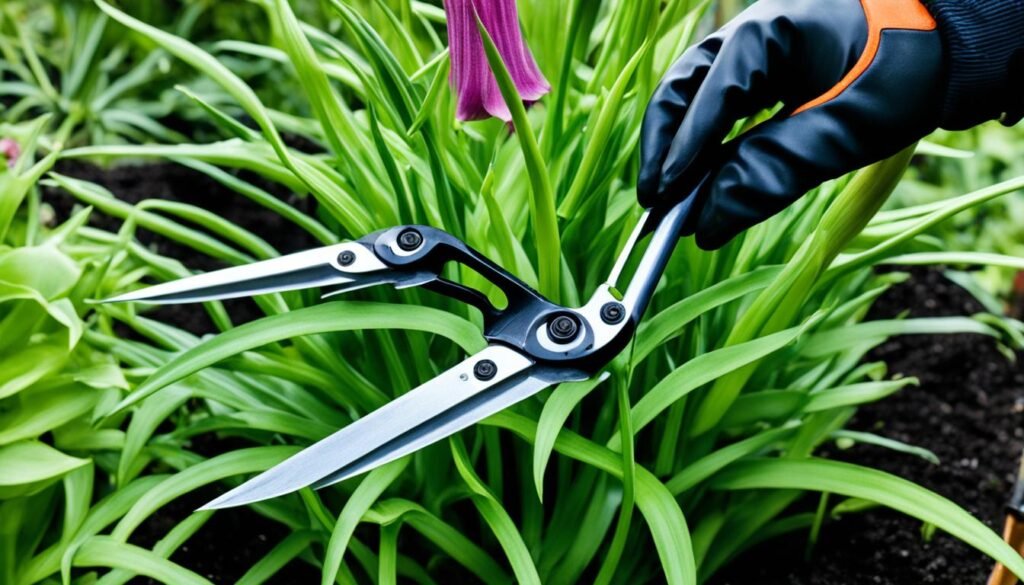Picture this: it’s a warm summer morning, and you’re sipping your coffee in the peaceful serenity of your garden. As you take in the beauty around you, something catches your eye. Amongst the vibrant colors of your flowers, there is a mesmerizing sight – the dark, almost black blooms of the Black Wizard Lilies.
These unique and exotic lilies are a true showstopper. With their deep, velvety petals and delicate fragrance, they add an air of mystery and elegance to any garden. But how can you grow and care for these enchanting flowers? Look no further – in this grow tips and care guide, I will share everything you need to know about cultivating Black Wizard Lilies.
Key Takeaways:
- Black Wizard Lilies are known for their dark, almost black flowers.
- They require full sun to part shade and well-draining soil.
- Plant the bulbs with the pointed side facing up, about 6 inches deep and 6 inches apart.
- Regular watering and balanced fertilization are essential for their growth.
- Mulching helps with moisture retention and weed control.
Choosing the Right Location
When planting black wizard lilies, it is important to choose the right location in your garden. These lilies require full sun to part shade, so select an area that receives at least 6 hours of sunlight per day. The soil should be well-draining and rich in organic matter. Avoid areas with standing water or heavy clay soil.
Planting black wizard lilies in the correct location is crucial for their growth and blooming. By providing the ideal conditions, you can ensure that your lilies flourish and showcase their enchanting dark blooms.
Here are some factors to consider:
- Light exposure: Black wizard lilies require at least 6 hours of sunlight each day to thrive. Choose a spot in your garden that receives ample sunlight, preferably with a combination of direct sunlight and partial shade.
- Soil drainage: Ensure that the soil in the selected location is well-draining. Black wizard lilies prefer moist but not excessively wet soil. Heavy clay soil or areas prone to standing water should be avoided.
- Soil fertility: These lilies perform best in rich, organic soil. Prior to planting, amend the soil with compost or well-rotted manure to improve its fertility and provide essential nutrients for the lilies.
Avoiding Common Mistakes
Location selection plays a fundamental role in the success of your black wizard lilies. Here are some common mistakes to avoid:
“Choosing a location without considering sunlight requirements can result in poor growth and lack of blooming. Additionally, planting in poorly drained soil can lead to root rot and other issues.”
By taking the time to select the right location, you set the stage for healthy and vibrant black wizard lilies. With proper sunlight, well-draining soil, and optimal fertility, your lilies will thrive and add a touch of elegance to your garden.
| Factors to Consider | Selection Criteria |
|---|---|
| Light exposure | Full sun to part shade (6 hours of sunlight per day) |
| Soil drainage | Well-draining soil |
| Soil fertility | Rich in organic matter |
Planting Black Wizard Lilies
To plant black wizard lilies, follow these simple steps:
- Dig a hole: Start by digging a hole that is approximately 6 inches deep. This depth will provide enough room for the bulb to establish itself and grow.
- Place the bulb: Once the hole is ready, carefully place the black wizard lily bulb in the hole with the pointed side facing up. This orientation will ensure proper growth and development.
- Spacing: When planting multiple black wizard lily bulbs, make sure to space them about 6 inches apart. This spacing allows for sufficient airflow and room for each bulb to grow without overcrowding.
- Cover and firm: Once the bulbs are in place, cover them with soil and gently firm it down. This will help secure the bulbs in the ground and provide stability as they begin to root and grow.
- Thoroughly water: After planting, water the area thoroughly to help settle the soil around the bulbs and provide them with the moisture they need for growth.
By following these planting guidelines, you can ensure that your black wizard lilies have the best start and will thrive in your garden.

Expert Tip
“When planting black wizard lilies, remember to choose a location that provides the optimal amount of sunlight and has well-draining soil. These lilies thrive in full sun to part shade and require soil with good drainage to prevent waterlogging.”
| Planting Black Wizard Lilies | |
|---|---|
| Step 1: Dig a hole | Approximately 6 inches deep |
| Step 2: Place the bulb | Pointed side facing up |
| Step 3: Spacing | About 6 inches apart |
| Step 4: Cover and firm | Gently firm the soil down |
| Step 5: Thoroughly water | After planting |
Watering and Fertilizing
Proper watering and fertilizing are essential for the healthy growth of black wizard lilies. Here are some care tips to ensure your lilies thrive:
Watering Black Wizard Lilies
Black wizard lilies require regular watering to maintain evenly moist soil, particularly during the growing season. However, it’s important to avoid overwatering, as they prefer well-drained soil. Here are a few watering tips:
- Water the lilies deeply, ensuring the moisture reaches the root zone.
- Check the soil moisture regularly by inserting your finger into the soil. If it feels dry about an inch below the surface, it’s time to water.
- During periods of high temperatures or drought, you may need to increase the frequency of watering to prevent the soil from drying out completely.
- Avoid overhead watering, as it can lead to foliage diseases. Instead, use a soaker hose or drip irrigation to water at the base of the plants.
Fertilizing Black Wizard Lilies
Applying a balanced fertilizer in early spring can provide the necessary nutrients for healthy growth and abundant blooms. Follow these care tips when fertilizing your black wizard lilies:
“I recommend using a slow-release, granular fertilizer formulated for flowering plants.”
An ideal fertilizer for black wizard lilies should have a balanced ratio of nitrogen (N), phosphorus (P), and potassium (K), such as a 10-10-10 or 14-14-14 blend. Here’s how to fertilize your lilies:
- Before applying the fertilizer, moisten the soil around the lilies.
- Follow the manufacturer’s instructions for the recommended application rate and method.
- Spread the fertilizer evenly around the plants, keeping it a few inches away from the stems to prevent burning.
- Gently work the fertilizer into the soil surface and water thoroughly.
- Repeat the fertilization process annually in early spring to support continuous growth and blooming.
Remember, moderation is key when it comes to fertilizing black wizard lilies. Too much fertilizer can result in excessive foliage growth and reduced flowering. Always follow the instructions provided by the manufacturer and adjust the application rate based on your specific soil conditions and the needs of your plants.
| Fertilizer Type | Application Rate | Frequency | Additional Notes |
|---|---|---|---|
| Granular, slow-release | As directed by the manufacturer | Once a year, in early spring | Water thoroughly after application |
| Liquid, water-soluble | As directed by the manufacturer | Every 2-4 weeks during the growing season | Dilute the fertilizer according to instructions |
Proper watering and fertilizing will help your black wizard lilies thrive and produce stunning, dark blooms. By following these care tips, you’ll ensure your lilies stand out in your garden and bring joy year after year.
Mulching and Weed Control
Mulching around black wizard lilies is an important step in their care and maintenance. By applying a layer of organic mulch, such as wood chips or straw, you can provide numerous benefits to your lilies.
Firstly, mulching helps to conserve moisture in the soil, preventing it from drying out too quickly and ensuring that your lilies receive a steady supply of water. This can be particularly beneficial during hot summer months or in regions with limited rainfall. The mulch acts as a barrier, reducing evaporation and keeping the soil moist for longer periods.
Additionally, mulch helps to suppress weed growth around your black wizard lilies. Weeds not only compete with the lilies for nutrients and water but also detract from the overall aesthetic appeal of your garden. By suppressing weed growth, mulching saves you time and effort spent on weed removal, allowing your lilies to thrive without unnecessary competition.
Furthermore, mulch helps regulate soil temperature, providing insulation during both hot and cold weather conditions. This can help protect the lilies’ delicate roots from extreme temperatures, ensuring their well-being and promoting healthy growth.
To correctly mulch your black wizard lilies, apply a 2-3 inch layer of organic mulch around the base of the plants, taking care not to cover the bulbs themselves. Leaving a small space around the bulbs prevents excess moisture retention, which can lead to rotting. As the mulch gradually breaks down, it also adds valuable nutrients to the soil, enriching it and enhancing the overall fertility.
In addition to mulching, it is important to regularly remove any weeds that may manage to grow in the mulched area. Weeds compete with the lilies for vital resources, such as water and nutrients, and can hinder their growth if left unchecked. Take the time to inspect the mulched area regularly and promptly remove any weeds you come across, ensuring your black wizard lilies have the best conditions to thrive.

Pruning and Deadheading
Pruning black wizard lilies is not typically necessary, as these resilient plants generally do not require extensive maintenance. However, it is important to remove any dead or damaged foliage as needed to promote the overall health and appearance of the plants.
Deadheading, the process of removing spent flowers, can be beneficial for black wizard lilies. By removing the faded blooms, you redirect the plant’s energy towards producing new flowers and extending the blooming period. Deadheading also helps keep the plants looking tidy and encourages their overall growth and vitality.
To deadhead black wizard lilies, gently pinch or snap off the faded flowers at the base of the stem. Be careful not to damage any emerging buds or leaves. It is best to deadhead regularly throughout the blooming season to ensure continuous blooms and enhance the aesthetic appeal of your garden.
Benefits of Deadheading:
- Encourages New Blooms: Removing spent flowers redirects the plant’s energy towards producing new blooms.
- Prolongs Blooming Period: Deadheading can extend the overall duration of the blooming season for black wizard lilies.
- Promotes Neat Appearance: Regularly removing faded flowers helps keep the plants looking tidy and well-maintained.

Note: The image above illustrates the process of pruning black wizard lilies.
Pest and Disease Control
Black wizard lilies are known for their resilience against pest and disease issues. However, it’s important to keep an eye on your plants and take appropriate measures to prevent and address any potential problems. Regular monitoring and good gardening practices can go a long way in maintaining the health of your black wizard lilies.
When it comes to pest control, two common culprits that may affect your black wizard lilies are aphids and snails. Aphids are small insects that feed on plant sap, causing damage to the leaves and stems. To control aphids, you can try using insecticidal soap or a strong stream of water to wash them away.
Tip: To tackle aphids, I prefer using organic insecticidal soap, as it is safe for the environment and doesn’t harm beneficial insects.
As for snails, they can munch on the leaves of your lilies, leaving behind unsightly damage. To deter snails, you can create barriers around your plants using materials like crushed eggshells or diatomaceous earth. These substances create uncomfortable surfaces that snails are reluctant to cross.
Aside from pests, disease control is essential to ensure the longevity of your black wizard lilies. Practicing good garden hygiene and providing proper air circulation can help prevent disease issues. Avoid overwatering your plants, as excess moisture can create a favorable environment for fungal diseases.
Pro Tip: When watering your black wizard lilies, aim to keep the soil evenly moist but not waterlogged. This will help prevent common fungal diseases like root rot.
If you notice any signs of disease, such as discolored or spotted leaves, it’s important to take action promptly. Remove any affected foliage and dispose of it in a sealed bag to minimize the chances of spreading the disease. Applying a fungicide specifically formulated for lilies can also help protect your plants.
By implementing these pest control and disease prevention methods, you can ensure that your black wizard lilies thrive and continue to enchant your garden with their stunning dark blooms.
Common Pest and Disease Control Measures for Black Wizard Lilies
| Pest or Disease | Control Measures |
|---|---|
| Aphids | – Use insecticidal soap or a strong stream of water – Introduce beneficial insects like ladybugs or lacewings – Plant companion plants that repel aphids |
| Snails | – Create barriers using crushed eggshells or diatomaceous earth – Handpick and remove snails manually – Encourage natural predators like birds or frogs |
| Fungal Diseases | – Practice good garden hygiene and provide proper air circulation – Avoid overwatering and waterlogged soil – Remove and dispose of affected foliage promptly |
Overwintering and Dormancy
Black wizard lilies are hardy plants that can withstand winter temperatures. As the weather cools, the foliage will naturally die back. It is important to leave the dead foliage in place, as it provides protection for the bulbs during the dormant period. Avoid cutting back the foliage until it turns brown and withers away. Mulching the area can also provide additional insulation.
During the winter months, black wizard lilies enter a period of dormancy. This is a natural part of their growth cycle, and it allows the bulbs to rest and conserve energy for the following growing season. It is important to avoid disturbing the bulbs during this time and to provide them with the necessary conditions to thrive.
To ensure successful overwintering of your black wizard lilies, follow these tips:
- Leave the dead foliage in place to protect the bulbs.
- Avoid cutting back the foliage until it turns brown and withers away.
- Apply a layer of mulch over the area to provide insulation.
By following these guidelines, you can help your black wizard lilies survive the winter and emerge strong and healthy in the spring. Remember to remove the mulch and gently prune away any remaining dead foliage as the new growth begins to appear.
During the dormant period, it is normal for black wizard lilies to remain dormant and not show any signs of growth. However, if you notice any signs of damage or disease during this time, take the appropriate measures to address the issue and ensure the health of your plants.

Propagation and Division
Black wizard lilies can be propagated through division. After several years of growth, the bulbs may produce small offsets or bulblets. These can be carefully separated from the parent bulb and planted individually to encourage new plants. Division is typically done in the fall when the plants are dormant.
How to Propagate Black Wizard Lilies
To propagate black wizard lilies, follow these steps:
- Carefully dig up the parent bulb, ensuring not to damage the offsets.
- Gently separate the offsets from the parent bulb, ensuring each one has its own roots.
- Plant the offsets in a separate location, providing them with the same growing conditions as the parent plant.
- Water the newly planted offsets and continue to provide proper care and maintenance.
By propagating black wizard lilies through division, you can expand your collection of these beautiful and enchanting flowers.
“Division is a simple and effective method for propagating black wizard lilies. By carefully separating the offsets and planting them individually, you can create new plants that will bloom for years to come.”

Conclusion
Black wizard lilies are a unique and striking addition to any garden. Their dark, almost black blooms add a touch of mystery and allure to any landscape. With proper care and attention, these exotic lilies will reward you with their captivating beauty year after year.
To ensure the success of your black wizard lilies, it is important to follow the grow tips and care guide provided in this article. Choose the right location in your garden, providing them with the ideal amount of sunlight and well-draining soil. Plant the bulbs at the right depth and spacing, and water and fertilize them properly. Mulching and weed control are important for their overall health and vitality.
While black wizard lilies are relatively pest and disease resistant, it is still important to monitor them regularly and take appropriate measures if any issues arise. Practice good garden hygiene and provide proper air circulation to prevent disease problems. Overwintering and dormancy are vital stages for the plants, so make sure to leave the dead foliage in place and provide adequate insulation during the colder months.
By following these care instructions, you can enjoy the beauty and enchantment of black wizard lilies in your own garden. Create a captivating display that showcases their unique blooms and adds a touch of mystique to your outdoor space. Cultivate these exotic lilies with care, and they will continue to amaze and delight you for years to come.
